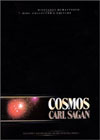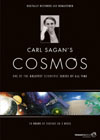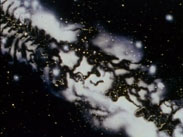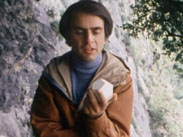Data Capsule Review
|
|
by Martin Izsak
|
Episode Seven of "Cosmos" can be considered the sleeping gem
of the series. The bulk of it will be spent digging through
the ancient history of Greece to find the origins of scientific
thought and what might be considered to be its opposition.
The reason I say that this gem is sleeping is because of the "wet"
and possibly uninspiring way that the episode meanders through its
opening sections. For quite some time, it appears that Carl Sagan
is merely being self-indulgent, revisiting his old haunts in Brooklyn,
sharing his awesome Voyager photos of the moons of Jupiter with
the new kids in his old Grade 6 classroom. One gets the feeling
that he isn't quite sure where to take this series after the
great excitement of episode six, and we are instead trying to re-live
past glories.
|
Participants include:
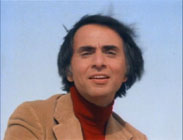 |
Dr. Carl Sagan
Astronomer, host, narrator
Voyager imaging team
Professor of Astronomy and Space Sciences,
Cornell University, Ithaca, New York
|
|
|
We also get quite a cheesy impersonation of a "primitive tribesman" from the first
age of fire, trying to figure out what the stars are - who suspiciously thinks quite like
Sagan in ways that I'm not quite willing to buy.
Hopefully, these sections won't whittle the audience down too much, because
the episode actually gets to be quite fascinating after that. Sagan goes to
many historically important places in Greece, recounting what he knows of many
of the figures who were important in shaping science and, more importantly,
the philosophy of what constitutes good science and an effective means of
learning how the universe ticks.
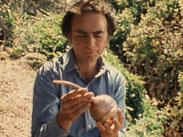
|
Perhaps this episode could have additionally "woken up"
with some actual re-enactments by actors
in costume, as has happened often in other episodes, because Sagan tells the stories
of about 10 or 11 different Greek figures as he goes along, most with difficult-to-pronounce
names that sound a bit too similar to each other. At the end of the day, it's easy
to get one or two of them confused, or to not be able to really remember who did what.
However, the odd mentions of Kepler and Huygens are accompanied by reused footage
from the episodes where their stories were re-enacted, and they pop out so much easier
and remain so much more memorable.
|
|
But it seems to me that the philosophies recounted here are the true heart
of what "Cosmos" is really all about - the heart of what Sagan and his colleagues
hold so dear. It would be a shame if this episode were upstaged by other more
flashy episodes of the series. Let's hold this gem up to the light.
Some of the Greek figures talked about here like Pythagoras or Plato are
quite famous in our culture, most noticeably for their most enduring achievements.
But Sagan digs deeper to uncover more than we usually hear about, and we see some
of the darker, less enlightened, more oppressive sides of their characters.
Whether or not the research of Sagan and his colleagues is pinpoint accurate or not
may be beside the point. The story that emerges is one where great discovery and
advancement exists side-by-side with the desire to see only what one wants to see,
and we contrast scientific methods emphasizing observations and experiments with
pure theory, pure thought, and revelation in a kind of sensory-isolation.
I think that's a great story to tell, and Sagan does it here with a lot of
fascinating depth, although sadly, it's mostly just in dialogue, with the support
of some of the actual locations (very beautifully photographed I must add)
and a number of quite intriguing props.
|
|
And I find this episode becomes more intriguing with time, as we learn more
about things that have been hidden on our world for a long time. As in episode 1,
the theme of science being lost as civilizations collapse is brought up again,
and we gain some rare insights into a cyclical facet to Human progress. Indeed,
one wonders if some of the figures mentioned here were not so much the discoverers
of the things we attribute to them, but rather the ambassadors of those discoveries,
as they bring them back to us from unseen masters in some hidden political control
structure. It may just be the answer that makes the most sense of their
"enlightened" discoveries coexisting with their "unenlightened" philosophies
of embracing a slave society and various other control-happy notions,
as we defeat the control systems still imposed on us today and uncover
the deeper and darker history those systems have had on us during our entire
time on this planet.
For me, one of the great mysteries of "Cosmos" is how this episode can be
reconciled with the next. Here, Sagan and friends obviously favour observation
and highly doubt the accuracy of pure thought and revelation. However, it is curious
that their presentation of Einstein's theories in the next episode makes it seem as if
Einstein derived his most famous material almost entirely from the revelation
of experiments of pure thought alone. Quite the apparent contradiction.
On closer inspection, I'm not sure Sagan or his colleagues realized that they were giving
off that impression.
The final portions of the episode, where we return to the classroom, continue
to be excellent and inspiring. Cosmos truly is rich in prophecy here, as many of
the predictions Sagan makes about the discoveries of planets of other star systems
have now come true, using the methods he describes to the sixth grade classroom in
Brooklyn. Very nice sequence.
Episode Seven bows out on a high, and remains one of my most favourite
episodes of the series.
|
International Titles:
Deutsch: Unser Kosmos - "Das Rückgrat der Nacht"
Español: Cosmos - "El espinazo de la noche"
Magyar: Kozmosz - "Ha leszáll az éj"
Русский: Космос - "Хребет ночи"
Français: "L'épine dorsale de la nuit"
Italiano: "La spina dorsale della notte"
|
|
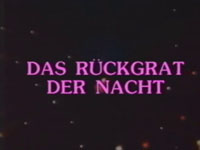
|
The Music - Episode 7
(Anything written in green text
represents a name I made up to help keep some music better identified in my own head.)
(Golden yellow backgrounds indicate selections that also appear on Voyager's Golden Record.)
| Collectors' Edition 2000 (DVD) |
Original 1980 | |
| Composer/Performer | Title 2000 |
Composer/Performer | Title 1980 | Notes |
| Vangelis | Symphony to the Powers B, Movement Three
also known as "Theme from Cosmos" |
Title Music |
| Vangelis | Creation Du Monde | |
| Louis Armstrong | Melancholy Blues | four excerpts |
| Dmitri Shostakovich | Symph. 11 Mvmt. 1 - "The Palace Square",
part A | |
| Vangelis | Creation Du Monde | |
| Alan Hovhaness | Symphony No. 19 - few seconds of tinkling |
Floating World - a few seconds of tinkling | (two excerpts) |
| Melanesian Panpipes - Solomon | |
| Vangelis | Creation Du Monde | |
Claude Debussy / Isao Tomita |
| Symphony No. 19 - few seconds of tinkling |
The Engulfed Cathedral |
Alan Hovhaness | Floating World
- bigger excerpt | |
| Andrzej Panufnik | Sinfonia Sacra (several excerpts)
(classical moods, percussion, fanfares) | |
| Alan Hovhaness | Floating World (fanfare bit)
(on top of previous cues) | @ 14:12 |
| Claude Debussy / Isao Tomita | The Engulfed Cathedral
(very spacey electronic sound) |
Jan Garbarek | Viddene (end)
Dis |
Dick Walter
|
In The Taverna (Greek plucking music)
|

(Christodoulos Halaris) |
My Mountain |

(Christodoulos Halaris) |
 | from the album: |
 |
("Orchestrikon" which means orchestral or instrumental) 2 cues. | |
| Andrzej Panufnik | Sinfonia Sacra (several excerpts merged) | |
| J.S. Bach | Air on G (played on strings) |
J.S. Bach / J.P. Rampal | Air on G (played on flute) | 25:20 |
| Claude Debussy / Isao Tomita | Footprints in the Snow
The Engulfed Cathedral
(on top of previous cue) |
Jan Garbarek | Dis (from middle)
Viddene (on top) |
discovering air |
| ?? local band? | ??? unknown (Greek Café music) | 29:35 - 33:50 |
| Keith Mansfield | Percussion Link 1 & 2 (drum rolls
- partly overlapping each other) |
Andrzej Panufnik
Alan Hovhaness
| Sinfonia Sacra - drum rolls
Floating World
(2nd trombone wow) |
| Erik Satie | Gymnopedie No. 3
(on flute, guitar, & harp) |
Erik Satie | Gymnopedie No. 1 (orchestra) | 35:00 - 36:10 |
| Brian Eno | Events in Dense Fog | Dodecahedron
36:20 - 37:37
38:10... again |
| Vangelis | Entends Chiens #2 - Ancient Angles
(tiny snippet from end)
Entends Chiens #10 - Libra Lullaby
What's this? |
Penderecki | De Natura Sonoris #2 |
| Brian Eno | Events in Dense Fog | |
| ??? unknown - (Greek Café music) | |
| George Crumb | Black Angels, Movement 3 - Return | (Kepler ...40:50) |
| Erik Satie | Gymnopedie No. 3 (2nd half)
(on flute, guitar, & harp) |
Erik Satie | Gymnopedie No. 3 (orchestra) | 41:47... |
| Andrzej Panufnik | Sinfonia Sacra (drumming bits) |
Penderecki | De Natura Sonoris #2 | 42:15 |
| Johann David Heinichen | Concerto S233 for 2 Horns and 2 Flutes
in F Major
Movement 2 - Andante poco Allegro |
J.S. Bach / J.P. Rampal | Air on G (played on flute) | 42:49 |
| Erik Satie | Gymnopedie No. 3 (reaches end)
(on flute, guitar, & harp) |
Erik Satie | Gymnopedie No. 2 (orchestra) |
| Wolfgang Mozart | Clarinet Concerto K622 in A Major
Movement 1 (famous string opening) |
Erik Satie | Gymnopedie No. 2
(2nd half, orchestra) |
...47:00 |
| Dmitri Shostakovich | Symph. 11 Mvmt. 1 - "The Palace Square",
part C | back to Brooklyn
classroom |
| Vangelis | Theme from Cosmos | 55:00
Kids inspired
-> into credits |
| Vangelis | Comet 16 | 58:01 Collector's Edition 2000 Credits |
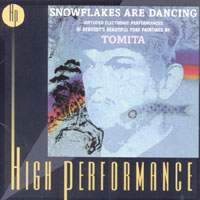
Isao Tomita
Snowflakes are Dancing
Original music
composed by
Claude Debussy
and realized electronically
by Isao Tomita
Audio CD
|
Physical Audio CD:
Tomita - Snowflakes Are Dancing
All Tracks by Claude Debussy
and re-imagined by Isao Tomita
This album available on CD or MP3 download.
Track Listing:
1. Snowflakes Are Dancing (2:14)
2. Reverie (4:49)
3. Gardens in the Rain (3:46)
4. Clair de Lune (5:53)
5. Arabesque No. 1 (4:03)
6. The Engulfed Cathedral (6:23)
7. Suite bergamasque No. 4 - Passepied (3:23)
8. The Girl with the Flaxen Hair (3:31)
9. Golliwogg's Cakewalk (2:55)
10. Footprints in the Snow (4:36)
11. Prelude to the Afternoon of a Faun (10:18)
|
Mp3 Album:
|
|
|
U.K.


|
Tomita - Snowflakes Are Dancing
All Tracks by Claude Debussy
and re-imagined by Isao Tomita
This album available on CD or MP3 download.
Track Listing:
1. Snowflakes Are Dancing (2:14)
2. Reverie (4:49)
3. Gardens in the Rain (3:46)
4. Clair de Lune (5:53)
5. Arabesque No. 1 (4:03)
6. The Engulfed Cathedral (6:23)
7. Suite bergamasque No. 4 - Passepied (3:23)
8. The Girl with the Flaxen Hair (3:31)
9. Golliwogg's Cakewalk (2:55)
10. Footprints in the Snow (4:36)
11. Prelude to the Afternoon of a Faun (10:18)
|
This documentary has become available on DVD.
Cosmos - by Carl Sagan: A Personal Voyage
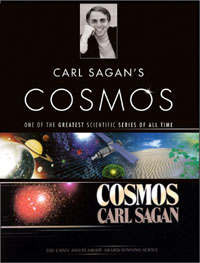
13 hour-long episodes, 1980
|
U.S.


| Canada


| U.K.


|
Comments on this article are welcome. You may contact
the author from this page:
Contact page
|
